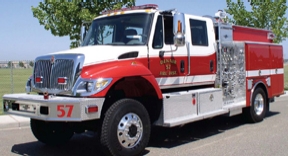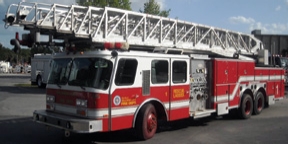 By Paul Darley
By Paul Darley
President and CEO
W.S. Darley & Co.
In January, I had the opportunity to address the Fire Department Safety Officers Association (FDSOA) at its annual Fire Apparatus Symposium in Orlando, Fla. If you’ve never had a chance to attend the FDSOA, you should check it out.
 |
 |
Many industry leaders, both manufacturers and fire departments, meet in a rather intimate setting (about 400 attend each year) and discuss cutting edge topics in the design, manufacture and service of fire apparatus and related equipment.
My presentation was titled “Fire Apparatus Innovations – Now and in the Future.” Having grown up around fire apparatus literally my entire life, it was a subject near and dear to my heart. I was asked to present because I had delivered a similar paper to the Metro Fire Chiefs at their annual conference in May of 2010. I spoke on behalf of the Fire Apparatus Manufacturers’ Association (FAMA).
I’ve attended FDSOA about 15 of the last 23 years, and there is always a lot of excitement in the air. Most of us have not seen each other since the trade show circuit ended in the fall. Manufacturers are quietly discussing new products that they will be releasing at the FDIC, and there is usually enough industry gossip to make a sixth-grade girl blush.
This year there was a somber undercurrent, as the FDSOA took place just two days after industry giant Bob Barraclough died after a long illness. Among other things, Bob was one of the founders of the FDSOA symposium.
Statistical Data
I am a big believer that data speaks louder than anecdotal evidence. Therefore, as I began to conduct research for this paper, I was surprised at how much statistical data on the fire service was available. FAMA has detailed statistics on the number of and types of trucks sold each year, but most of this information is reserved for member use only.
The National Fire Protection Association (NFPA), the National Volunteer Fire Council (NVFC), the International Association of Fire Chiefs (IAFC), the Federal Emergency Management Agency (FEMA) and the U.S. Fire Administration all offer a plethora of information on their Web sites that few people seem to know about or use. I drew on this data to support the trends that I saw changing in fire service.
When preparing the paper, I also solicited and received information and photographs from many of our more than 100 FAMA members on recently-released products. For the FDSOA, I needed to consolidate these innovations into a 30-minute presentation, but you can download a copy of the entire PowerPoint presentation at the FAMA Web site at www.fama.org/resourcelibrary/. While there, I would also encourage you to download the FAMA white paper that highlights changes in fire apparatus since 1994.
Drastic Change
The biggest take-away from my research is that the fire service is changing drastically, and most fire apparatus manufacturers are designing vehicles to meet these changing needs. I know this may sound almost trivial, but take a close look at the data and the new products that are being introduced.
It might come as a surprise to learn that in 2009, less than five percent of all fire service responses were actual fire calls. According to the NFPA, roughly 65 percent of all calls were medical aid or EMS related. While the percentage of fire call responses has declined greatly during the last 30 years, total calls have more than tripled.
It is also interesting to note that while both the percentage and number of fire calls declined, the damage caused (in constant dollars) has actually risen. So while there are fewer fires, the ones we are having are larger, and departments still need big water capability.
To quote IAFC Past President Jeff Johnson, “While all the hats and shirts you own have the word “fire department” on them, let’s face it, responding to fire is not what we do with the bulk of our response time.”
However, the number of natural and technical disasters taking place around the world is growing at a staggering rate. Our minds shift quickly to major events such as Katrina, Haiti and the BP oil spill in the gulf, but the fact is that these type of disasters are increasing all over the world.
Here in the U.S., wildfires during the past five years have been more intense and costly than at any other time in recorded history. With few exceptions, our fire and rescue services are the first called to these responses.
Drivers Of Change
NFPA 1901, which covers the standards for fire apparatus design and manufacture, has been overhauled several times in recent years – in 1996, 1999 and most recently in 2009. The 2009 changes were the most radical, comprehensive and costly of the last 15 years. Most of the changes were based on safety, but they added significantly to the cost of the vehicle.
There is an old misconception that the manufacturers drive the NFPA changes. The fact is that the NFPA 1901 committee is comprised of three equal size groups – fire service personnel, industry experts and manufacturers.
The federal Environmental Protection Agency emissions changes that took effect on Jan. 1, 2010 also added considerably to the cost of new vehicles. By most estimates, the costs of meeting the emission standards for 2010 added, on average, $25,000 to the price of a truck, and the cost of meeting the new NFPA standards added another $20,000 to $30,000.
Technological Advances
The technological advancements during the past 20 years have been tremendous. The use of electronics, such as pressure governors, have all but rendered relief valves obsolete. Multiplexing provides complete operations and diagnostics of virtually all fire apparatus functions.
Fire service budgets are being hit unlike ever before in our lifetime. By most estimates the market for new fire apparatus is down more than 40 percent from its peak in 2008 when an estimated 6,000 new vehicles were sold in the North American market.
Just 20 years ago, most of the booster tanks on the market were steel. Today I can count on one hand the number of new trucks with tanks that are anything but polypropylene. A few manufacturers are offering this and other non-metal bodies as an alternative. We saw a lot of this at Interschutz last year, and I can’t recall seeing a truck without electronics.
Class A Foam and compressed-air foam systems (CAFS) have also revolutionized the way we fight fire today.
During this time, new transmission technology was introduced that now allows for PTO pumps up to 1,500 gpm to be driven. Ninety percent of the fire services around the world drive their pumps via a power takeoff, and in my opinion, this change alone will radically change the face of vehicles in the future.
Multipurpose Vehicles
Based on the available statistical information, innovative departments will look to do more with smaller budgets and purchase apparatus that meet their true operational needs.
Coming from the pump business, I may be biased, but I am convinced that the days of taking up 50 to 60 inches of prime real estate behind the cab for a traditional full cast split-shaft midship pump are headed to an end. I believe most apparatus in the future will have PTO-driven pumps with big water for those rare, but important occasions when they are needed.
Those pumps offer ease of operation, maintenance, pump-and-roll capability and are less costly to own and maintain. Most importantly, they free up space on the truck to carry all the gear necessary to meet the needs of today’s first responders while keeping the truck with a reasonable wheelbase. For those departments not ready to switch completely away from split-shaft pumps, this can also be achieved through custom manifolding, which also frees up space.
You’ll continue to see manufacturers produce vehicles with patient transport capability, as well as fire, hazmat, rescue and advanced life support capabilities.
Most of the larger fire apparatus manufacturers understand the changing needs of the today’s fire service, and they are responding to them with new vehicles to meet your needs.
At this year’s FDIC, I would encourage you take a very close look at the trucks on display. I’ll bet you a steak dinner that most of the cutting edge fire apparatus builders will be introducing innovative products as described above. I’ll meet you at St. Elmo’s. Bring your wallet.
Editor’s Note: Paul Darley is president and CEO of W.S. Darley & Co. He is past president of the Fire Apparatus Manufacturers’ Association (FAMA) and served on the Board of Directors of the Fire and Emergency Manufacturers and Services Association (FEMSA). He has visited fire services in over 65 countries. He holds a bachelor’s degree in marketing and finance from Marquette University and an MBA from Northwestern University’s Kellogg School of Management.
More Fire Apparatus Current Issue Articles
More Fire Apparatus Archives Issue Articles

